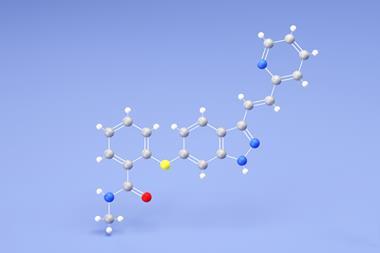Scientists have developed a complex for medical imaging that is only absorbed into cells when its luminescent metal cargo is inside
UK researchers have used a cage-like molecule to smuggle metal ions into cells, which could improve medical imaging.
Medical imaging often requires getting unnatural materials such as metal ions into cells. Scientists have therefore had to come up with ways to disguise these compounds to get them past the cell membranes. Michael Coogan and colleagues at Cardiff University have come up with a way to avoid the current difficulties with some of these imaging treatments.
Metal ions or other luminescent compounds are usually bound up in a lipophilic (fat loving) ligand to get them past the cell membrane. By using an excess of the ligand, it’s possible to ensure that none of the toxic (and often expensive) metal is left behind. However, this requires a time-consuming purification step, as too much of the ligand can often be harmful in its own right.
Coogan and his team have come up with a way round this problem. In the course of their work on fluorescent metal complexes, they found a neutral cage-like molecule that became positively-charged when it incorporated a metal ion. They realised that this could be very useful for medical imaging, because the combination of a lipophilic ligand and a positive charge is known to make it easier for complexes to get through cell membranes.
The team describes this concept as a ’sleeping Trojan horse’, alluding to the fact that the ligand is only able to enter cells (or ’wake up’) when the metal is complexed inside. ??The polypyridine ligand they’ve investigated can carry copper ions, so by using the isotope 64Cu, says Coogan, it could be used both for fluorescence detection and as an imaging agent for positron emission tomography (PET).

As well as this, Coogan adds, the concept could be applied to the specific and triggerable delivery of any sort of imaging or therapeutic agent, minimising unwanted uptake and the need for purification of drug?-carrier conjugates. For example, he says, ’triggered release of toxic metal ions once the "horse" reaches the target could provide chemotherapeutic agents.’
’This is a really elegant piece of work,’ says Nick Long, an expert in inorganic chemistry for medical imaging at Imperial College London, UK. ’The search for multifunctional or smart and switchable compounds is very topical, and Coogan’s harnessing of the movement into cells of a luminescent molecule via the encapsulation (or not) of metal ions is impressive. It will be particularly fascinating to see the development of this methodology for dual-modality optical and PET molecular imaging.’
David Barden
Link to journal article
Sleeping Trojan Horse
Flora L. Thorp-Greenwood, Vanesa Fern?ndez-Moreira, Coralie O. Millet, Catrin F. Williams, Joanne Cable, Jonathan B. Court, Anthony J. Hayes, David Lloyd and Michael P. Coogan,?
Chem. Commun., 2011,
47, 3096
DOI:10.1039/c1cc10141b






No comments yet